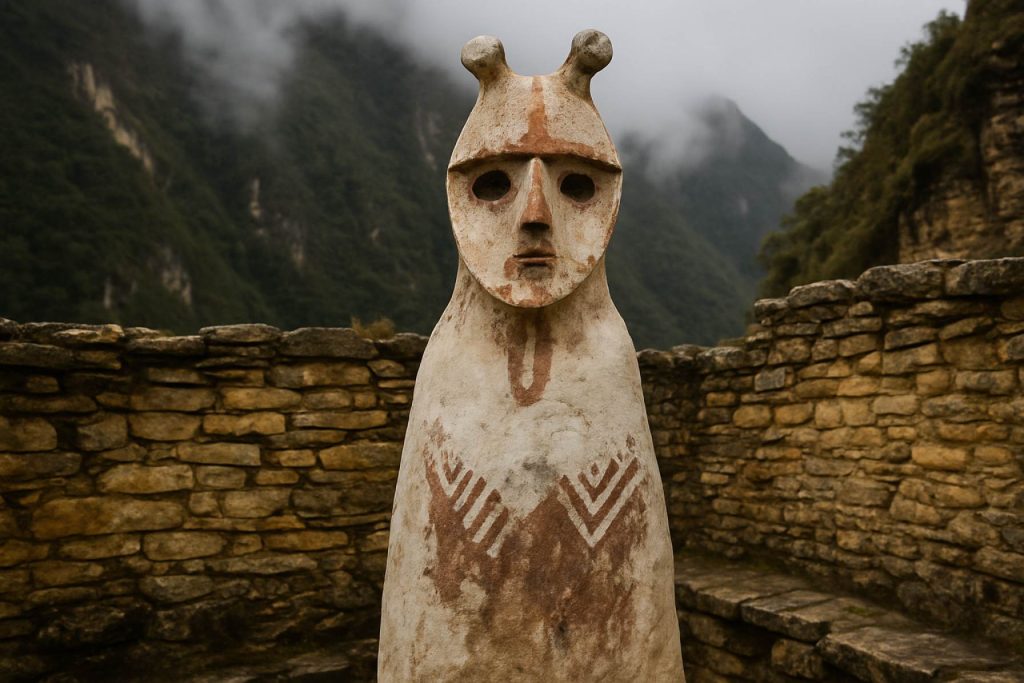
Inside the Enigmatic World of the Chachapoya Culture: Exploring the Cloud Warriors’ Legacy, Architecture, and Untold Stories of the Peruvian Andes
- Origins and Geographic Heartland of the Chachapoya
- Social Structure and Daily Life in Chachapoya Society
- Distinctive Architecture: Kuelap and Beyond
- Funerary Practices and the Sarcophagi of Karajía
- Art, Textiles, and Material Culture
- Interactions with Neighboring Civilizations and the Inca Conquest
- Religious Beliefs and Ritual Practices
- Archaeological Discoveries and Recent Excavations
- Genetic Studies and Modern Descendants
- Preservation Challenges and the Future of Chachapoya Heritage
- Sources & References
Origins and Geographic Heartland of the Chachapoya
The Chachapoya culture, often referred to as the “Warriors of the Clouds,” emerged in the cloud forests of the eastern slopes of the Andes in what is now northern Peru. Their origins are traced to the early first millennium CE, with archaeological evidence suggesting the development of a distinct society by at least the 9th century CE. The Chachapoya heartland was centered in the modern-day Amazonas region, particularly along the Utcubamba and Marañón river valleys. This area is characterized by steep mountains, dense cloud forests, and deep canyons, providing both natural fortification and a unique ecological niche for the Chachapoya people.
The geographic isolation of the region contributed to the development of a culture distinct from neighboring Andean civilizations. The Chachapoya constructed impressive settlements on ridges and mountaintops, the most famous being Kuélap, a massive stone fortress complex that served as a political and ceremonial center. The location of Kuélap and other sites reflects the Chachapoya’s adaptation to their rugged environment, utilizing the high-altitude cloud forests for agriculture, particularly the cultivation of maize, potatoes, and other Andean staples.
The Chachapoya territory bordered the Amazon basin to the east and the high Andes to the west, positioning them as intermediaries in trade and cultural exchange between the Amazonian lowlands and the Andean highlands. This strategic location facilitated the movement of goods such as coca leaves, feathers, and ceramics, and likely contributed to the cultural diversity observed in Chachapoya material culture. Despite their relative isolation, the Chachapoya were not immune to external influences, as evidenced by their eventual incorporation into the Inca Empire in the late 15th century.
Archaeological and ethnohistorical research, including studies by the Ministerio de Cultura de España and the British Museum, has helped to clarify the boundaries and characteristics of the Chachapoya heartland. These investigations reveal a network of settlements, burial sites, and agricultural terraces that underscore the complexity and adaptability of Chachapoya society. The region’s challenging geography not only shaped the Chachapoya’s defensive strategies and architectural styles but also played a crucial role in preserving many of their archaeological sites, which continue to be studied for insights into pre-Columbian Andean cultures.
Social Structure and Daily Life in Chachapoya Society
The Chachapoya culture, flourishing in the cloud forests of the northern Andes from approximately 900 to 1470 CE, developed a distinctive social structure and daily life shaped by their challenging environment. The Chachapoya, often referred to as the “Warriors of the Clouds,” inhabited the high-altitude regions of present-day northern Peru, where steep mountains and dense forests influenced their settlement patterns, architecture, and community organization.
Chachapoya society was organized into small, semi-autonomous communities, each typically centered around fortified settlements or villages. These communities were often built on ridges or mountaintops, such as the impressive site of Kuélap, which served both defensive and ceremonial purposes. The social hierarchy within these communities is believed to have been relatively egalitarian compared to other Andean cultures, with leadership roles likely based on kinship, age, and demonstrated ability rather than rigid hereditary classes. However, archaeological evidence suggests the presence of local elites who coordinated communal labor and religious activities, as indicated by larger residential structures and burial practices.
Daily life for the Chachapoya revolved around agriculture, with terraced fields carved into the mountainsides to cultivate crops such as maize, potatoes, and quinoa. The challenging terrain necessitated advanced agricultural techniques, including irrigation and soil management, to sustain their communities. In addition to farming, the Chachapoya engaged in hunting, gathering, and the domestication of animals like llamas and guinea pigs, which provided meat, wool, and transportation.
Social cohesion was reinforced through communal labor, particularly in the construction of monumental architecture and the maintenance of agricultural terraces. Religious and ceremonial life played a central role, with evidence of ancestor worship and complex funerary practices, such as the placement of mummified remains in cliffside tombs and sarcophagi. These practices not only honored the dead but also reinforced social bonds and collective identity.
Textile production was another important aspect of daily life, with the Chachapoya renowned for their fine weaving and distinctive patterns. Clothing and adornments often signified social status and community affiliation. Trade and interaction with neighboring cultures, including the Inca, introduced new goods and ideas, although the Chachapoya maintained a distinct cultural identity until their eventual incorporation into the Inca Empire in the late 15th century.
Much of what is known about Chachapoya social structure and daily life comes from archaeological investigations and the study of their architectural and funerary remains, as the Chachapoya left no written records. Ongoing research by institutions such as the British Museum and national heritage organizations in Peru continues to shed light on the complexity and resilience of this remarkable Andean culture.
Distinctive Architecture: Kuelap and Beyond
The Chachapoya culture, flourishing in the cloud forests of northern Peru from approximately 900 to 1470 CE, is renowned for its distinctive architectural achievements, most notably the monumental site of Kuelap. Perched atop a mountain ridge at 3,000 meters above sea level, Kuelap is often referred to as the “Machu Picchu of the North” due to its impressive scale and strategic location. The site comprises massive limestone walls—some reaching up to 20 meters in height—and encloses more than 400 circular stone structures. These buildings, characterized by their rounded forms and intricate friezes, reflect the Chachapoya’s unique construction techniques and aesthetic sensibilities.
Kuelap’s architecture demonstrates advanced engineering skills, with its defensive walls and narrow, easily defensible entrances suggesting a society concerned with security and social organization. The circular dwellings, often decorated with zigzag and diamond motifs, were typically built with local limestone and featured conical thatched roofs. The use of circular rather than rectangular floor plans distinguishes Chachapoya architecture from that of neighboring Andean cultures, such as the Inca, who favored rectilinear layouts. This preference for round structures is also evident in other Chachapoya sites, including Gran Pajatén and Revash, where similar construction methods and decorative elements are found.
Beyond residential and defensive structures, the Chachapoya are also known for their funerary architecture. Mausoleums and sarcophagi, often situated on inaccessible cliff faces, highlight the importance of ancestor veneration and the afterlife in Chachapoya belief systems. The sarcophagi of Karajía, for example, are anthropomorphic in form and constructed from clay, sticks, and stones, demonstrating both artistic creativity and technical skill. These funerary monuments, along with the monumental architecture of Kuelap, underscore the Chachapoya’s ability to adapt to their challenging environment and their sophisticated understanding of construction and landscape.
The preservation and study of Chachapoya architecture have been supported by organizations such as the United Nations Educational, Scientific and Cultural Organization (UNESCO), which recognizes the cultural significance of sites like Kuelap. Ongoing archaeological research continues to reveal new insights into the construction techniques, social organization, and cultural practices of the Chachapoya, highlighting their distinct place within the broader tapestry of Andean civilizations.
Funerary Practices and the Sarcophagi of Karajía
The funerary practices of the Chachapoya culture, which flourished in the cloud forests of northern Peru from approximately 900 to 1470 CE, are among the most distinctive in pre-Columbian South America. The Chachapoya are particularly renowned for their unique mortuary architecture, most notably the sarcophagi of Karajía. These funerary monuments, known locally as “purunmachus,” are anthropomorphic clay and stone coffins placed on high cliff ledges, often overlooking deep valleys. The placement of these sarcophagi in such inaccessible locations suggests a profound reverence for the dead and a desire to protect ancestors from both natural and human threats.
The sarcophagi of Karajía, discovered in the early 20th century, are among the best-preserved and most iconic examples of Chachapoya funerary art. Each sarcophagus stands up to 2.5 meters tall and is shaped to resemble a human figure, complete with stylized facial features and, in some cases, elaborate headdresses. The construction involved a framework of sticks and stones, covered with a clay-based plaster and painted with ochre and other natural pigments. These effigies typically contained the mummified remains of high-status individuals, often accompanied by grave goods such as ceramics, textiles, and personal ornaments, indicating the importance of social hierarchy in Chachapoya society.
The funerary sites were not limited to sarcophagi; the Chachapoya also constructed mausoleums—small, house-like structures built into cliff faces. Both types of burial reflect a complex belief system centered on ancestor veneration and the afterlife. The inaccessibility of these tombs may have served both practical and symbolic purposes: deterring looters and wild animals, while also emphasizing the separation between the world of the living and the realm of the ancestors.
Archaeological research and conservation efforts at Karajía and other Chachapoya sites have been supported by the Ministry of Culture of Peru, which recognizes the cultural and historical significance of these funerary monuments. The preservation of the sarcophagi is a priority, given their vulnerability to environmental degradation and illicit trafficking. Ongoing studies continue to shed light on the mortuary customs, social organization, and spiritual beliefs of the Chachapoya, contributing to a broader understanding of Andean civilizations.
Art, Textiles, and Material Culture
The Chachapoya culture, flourishing in the cloud forests of the northern Andes from approximately 900 to 1470 CE, is renowned for its distinctive art, textiles, and material culture. Their artistic expressions reflect both their unique environment and their interactions with neighboring Andean societies. Chachapoya artisans were skilled in a variety of crafts, producing objects that were both utilitarian and ceremonial in nature.
Textiles were among the most significant elements of Chachapoya material culture. Using cotton and camelid fibers, Chachapoya weavers created finely crafted fabrics characterized by geometric patterns, vibrant colors, and intricate embroidery. These textiles served not only as clothing but also as markers of social status and identity. The preservation of textiles in the region’s dry tombs has provided valuable insights into their weaving techniques and aesthetic preferences. The Chachapoya are particularly noted for their use of tapestry weaving and supplementary weft techniques, which allowed for complex designs and motifs, often featuring stylized animals, humans, and abstract forms.
Ceramics also played a vital role in Chachapoya daily life and ritual. Their pottery is typically hand-built and decorated with incised or painted geometric designs. Common forms include bowls, jars, and effigy vessels, some of which were used in funerary contexts. The iconography on Chachapoya ceramics often mirrors that found in their textiles, suggesting a shared symbolic language across different media.
In addition to textiles and ceramics, the Chachapoya excelled in stonework and wood carving. They constructed elaborate sarcophagi, known as purunmachus, which are anthropomorphic coffins placed on cliff faces. These sarcophagi are decorated with painted designs and sometimes adorned with human skulls, reflecting the Chachapoya’s complex funerary practices and beliefs about the afterlife. The culture’s architectural achievements, such as the monumental site of Kuélap, further demonstrate their sophisticated use of stone and their ability to manipulate their challenging environment.
The material culture of the Chachapoya is a testament to their adaptability, creativity, and the importance of visual expression in their society. Ongoing archaeological research continues to reveal new aspects of their artistry and craftsmanship, contributing to a deeper understanding of this enigmatic Andean civilization. For further information on Andean cultures and their material heritage, consult resources from the British Museum and the Metropolitan Museum of Art, both of which house significant collections and research on pre-Columbian South American societies.
Interactions with Neighboring Civilizations and the Inca Conquest
The Chachapoya culture, flourishing in the cloud forests of the northern Andes from approximately 900 to 1470 CE, developed in relative isolation due to the region’s rugged terrain. However, archaeological and ethnohistorical evidence indicates that the Chachapoya maintained dynamic interactions with neighboring civilizations, particularly those of the northern coast and highland Andes. Trade networks connected the Chachapoya with the coastal Moche and later the Chimú, facilitating the exchange of goods such as coca leaves, ceramics, textiles, and exotic feathers. These interactions are evident in the material culture found at Chachapoya sites, which display stylistic influences from both coastal and highland traditions.
The most significant external influence on the Chachapoya came from the Inca Empire. In the late 15th century, under the reign of Tupac Inca Yupanqui, the Incas launched a series of military campaigns to incorporate the Chachapoya region into their expanding empire. The conquest was met with fierce resistance; Chachapoya fortresses such as Kuélap and Gran Pajatén demonstrate the region’s defensive strategies and architectural ingenuity. Despite their efforts, the Chachapoya were eventually subdued, and their territory was integrated into the Inca administrative system.
Following the conquest, the Incas implemented policies of resettlement (mitma), forcibly relocating segments of the Chachapoya population to other parts of the empire to prevent rebellion and to facilitate cultural assimilation. In turn, groups from other regions were settled in Chachapoya territory. This process led to significant demographic and cultural changes, as evidenced by shifts in burial practices, ceramics, and settlement patterns. The Chachapoya also contributed to the Inca state as warriors, laborers, and artisans, and their expertise in cloud forest agriculture and construction was valued by the Inca administration.
Despite the Inca conquest, elements of Chachapoya identity persisted, as noted in early Spanish colonial accounts. The region’s remoteness and the resilience of its people allowed for the survival of certain traditions and social structures well into the colonial period. Today, ongoing archaeological research continues to shed light on the complex interactions between the Chachapoya, their neighbors, and the Inca, revealing a history of both conflict and cultural exchange. For further information on Andean civilizations and the Inca Empire, consult resources from the British Museum and the Government of Peru.
Religious Beliefs and Ritual Practices
The religious beliefs and ritual practices of the Chachapoya culture, which flourished in the cloud forests of the northern Andes of present-day Peru from approximately 900 to 1470 CE, were deeply intertwined with their environment and social structure. The Chachapoya, often referred to as the “Warriors of the Clouds,” developed a spiritual worldview that emphasized reverence for ancestors, the natural world, and the cyclical nature of life and death.
Central to Chachapoya religious life was ancestor worship. The Chachapoya constructed elaborate mausoleums and sarcophagi, such as those found at the site of Karajía, to house the mummified remains of their elite. These funerary practices suggest a belief in the continued influence of ancestors over the living, and rituals likely included offerings of food, textiles, and ceramics to honor and appease these spirits. The placement of tombs in high, inaccessible cliffs further indicates a desire to connect the deceased with the sky and the sacred landscape, reflecting a cosmology that linked the heavens, earth, and underworld.
Ritual practices were closely tied to the agricultural calendar and the rhythms of the cloud forest environment. Ceremonies to ensure fertility, successful harvests, and protection from natural disasters were likely held at sacred sites, including mountaintops and caves. Archaeological evidence, such as ceremonial plazas and petroglyphs, points to communal gatherings where music, dance, and offerings played a central role. The use of coca leaves and other plants in ritual contexts suggests shamanic practices aimed at communicating with spiritual forces and seeking guidance or healing.
The Chachapoya also demonstrated a strong connection to water sources, which were vital in their mist-laden territory. Springs and rivers may have been considered sacred, and rituals to honor water deities or spirits were likely integral to their belief system. The integration of natural features into ceremonial architecture, such as the alignment of structures with celestial events or landscape elements, further underscores the spiritual significance of their surroundings.
Following the Inca conquest in the late 15th century, elements of Chachapoya religious practice were absorbed into the broader Andean religious framework, which itself was later influenced by Spanish colonialism. However, the distinctiveness of Chachapoya ritual life remains evident in the archaeological record and ongoing research by institutions such as the Ministry of Culture of Peru and the British Museum, which continue to study and preserve Chachapoya heritage.
Archaeological Discoveries and Recent Excavations
The Chachapoya culture, often referred to as the “Warriors of the Clouds,” flourished in the cloud forests of the northern Andes of present-day Peru from approximately 900 to 1470 CE. Archaeological discoveries over the past several decades have significantly expanded our understanding of this enigmatic civilization, particularly through the excavation of monumental sites, funerary complexes, and distinctive architectural remains.
One of the most prominent archaeological sites associated with the Chachapoya is Kuélap, a massive stone fortress situated atop a mountain ridge. Excavations at Kuélap have revealed over 400 circular stone structures, ceremonial platforms, and defensive walls, indicating a complex urban center with sophisticated social organization. The site’s strategic location and formidable construction suggest its importance as both a political and ceremonial hub. Ongoing research and conservation efforts at Kuélap are overseen by the Ministry of Culture of Peru, which is responsible for the protection and management of Peru’s cultural heritage.
Beyond Kuélap, recent excavations have uncovered a network of Chachapoya settlements, burial sites, and sarcophagi scattered throughout the Amazonas region. The discovery of the cliffside mausoleums at Revash and the anthropomorphic sarcophagi of Karajía has provided invaluable insights into Chachapoya funerary practices. These burial sites, often located in inaccessible locations high on cliff faces, reflect the Chachapoya’s unique approach to honoring their dead and their advanced engineering skills. The Ministry of Culture of Peru has played a central role in documenting and preserving these fragile sites.
Recent archaeological projects have also employed advanced technologies such as LiDAR (Light Detection and Ranging) to map previously unknown Chachapoya settlements hidden beneath dense forest canopies. These surveys have revealed extensive agricultural terraces, road networks, and defensive structures, suggesting a far more populous and interconnected society than previously assumed. Collaborative efforts between Peruvian authorities and international research institutions have been instrumental in these discoveries, with findings regularly presented at conferences organized by the Society for American Archaeology, a leading global organization dedicated to archaeological research in the Americas.
Collectively, these archaeological discoveries and ongoing excavations continue to reshape our understanding of the Chachapoya culture, highlighting its complexity, adaptability, and enduring legacy in the Andean region.
Genetic Studies and Modern Descendants
Genetic studies of the Chachapoya culture, an ancient Andean civilization that thrived in the cloud forests of northern Peru, have provided valuable insights into their origins, population dynamics, and legacy among modern populations. The Chachapoya, often referred to as the “Warriors of the Clouds,” were known for their distinctive architecture, funerary practices, and resistance to Inca conquest. However, much about their ancestry and relationship to contemporary groups remained unclear until the advent of advanced genetic analysis.
Recent research utilizing ancient DNA (aDNA) extracted from Chachapoya skeletal remains has revealed a complex genetic landscape. Studies indicate that the Chachapoya exhibited a high degree of genetic diversity, suggesting interactions with neighboring Andean and Amazonian populations. Mitochondrial DNA (mtDNA) analyses, which trace maternal lineages, have shown affinities with both highland and lowland groups, supporting the hypothesis of the Chachapoya as a cultural and genetic crossroads between the Andes and the Amazon basin. This diversity is further corroborated by the presence of multiple haplogroups, indicating that the region was not isolated but rather a hub of migration and exchange.
The impact of Inca conquest and subsequent Spanish colonization on the Chachapoya gene pool has also been a subject of investigation. Genetic evidence suggests that, despite significant demographic upheaval, some degree of Chachapoya ancestry persists in the modern populations of the Amazonas region. Contemporary genetic surveys have identified markers consistent with ancient Chachapoya lineages among local indigenous communities, although admixture with other Andean and European groups is evident. This continuity is reflected not only in genetic data but also in the persistence of certain cultural practices and oral traditions among the region’s inhabitants.
Ongoing research, often conducted in collaboration with Peruvian institutions and international partners, continues to refine our understanding of Chachapoya genetic heritage. These studies are crucial for reconstructing the demographic history of the Andes and for recognizing the enduring legacy of the Chachapoya people. Organizations such as the Consejo Nacional de Ciencia, Tecnología e Innovación Tecnológica (CONCYTEC) of Peru play a key role in supporting scientific research in this field, fostering collaborations that bridge archaeology, genetics, and anthropology.
In summary, genetic studies have illuminated the Chachapoya’s role as a dynamic and interconnected society, whose descendants continue to shape the cultural and biological landscape of northern Peru. The integration of genetic, archaeological, and ethnographic data promises to further unravel the complexities of Chachapoya ancestry and their enduring influence in the region.
Preservation Challenges and the Future of Chachapoya Heritage
The preservation of Chachapoya heritage faces significant challenges due to a combination of environmental, human, and institutional factors. The Chachapoya, often referred to as the “Warriors of the Clouds,” inhabited the cloud forests of the northern Andes in present-day Peru. Their legacy includes remarkable stone settlements such as Kuélap, mausoleums, sarcophagi, and intricate textiles. However, the region’s humid climate accelerates the deterioration of organic materials and stone structures, making conservation efforts particularly complex.
One of the primary threats to Chachapoya sites is environmental degradation. The persistent moisture and biological growth in the cloud forest environment contribute to the erosion of stonework and the decay of mummified remains and textiles. Additionally, climate change is intensifying these effects, with increased rainfall and temperature fluctuations further destabilizing ancient structures. Natural disasters, such as landslides and earthquakes, also pose ongoing risks to the integrity of archaeological sites.
Human activity presents another set of challenges. Looting and illegal trafficking of artifacts have historically resulted in the loss of invaluable cultural materials. Encroachment from agriculture, infrastructure development, and unregulated tourism can damage sites and disrupt the surrounding landscape. While tourism offers economic opportunities, it also necessitates careful management to prevent overuse and ensure that visitor access does not compromise the preservation of fragile remains.
Institutional and resource limitations further complicate preservation efforts. Many Chachapoya sites are located in remote, difficult-to-access areas, making regular monitoring and maintenance logistically challenging. Limited funding and technical expertise can hinder the implementation of advanced conservation techniques. The Peruvian government, through the Ministry of Culture of Peru, is responsible for the protection and management of these sites, often collaborating with international organizations and research institutions to develop sustainable preservation strategies.
Looking to the future, the preservation of Chachapoya heritage will depend on a multifaceted approach. This includes continued scientific research, the application of new conservation technologies, and the involvement of local communities in stewardship roles. International cooperation, such as partnerships with UNESCO and other heritage organizations, can provide technical support and raise global awareness. Education and community engagement are essential for fostering a sense of ownership and responsibility among local populations, ensuring that the legacy of the Chachapoya endures for generations to come.
Sources & References
- United Nations Educational, Scientific and Cultural Organization (UNESCO)
- Metropolitan Museum of Art
- Consejo Nacional de Ciencia, Tecnología e Innovación Tecnológica (CONCYTEC)



